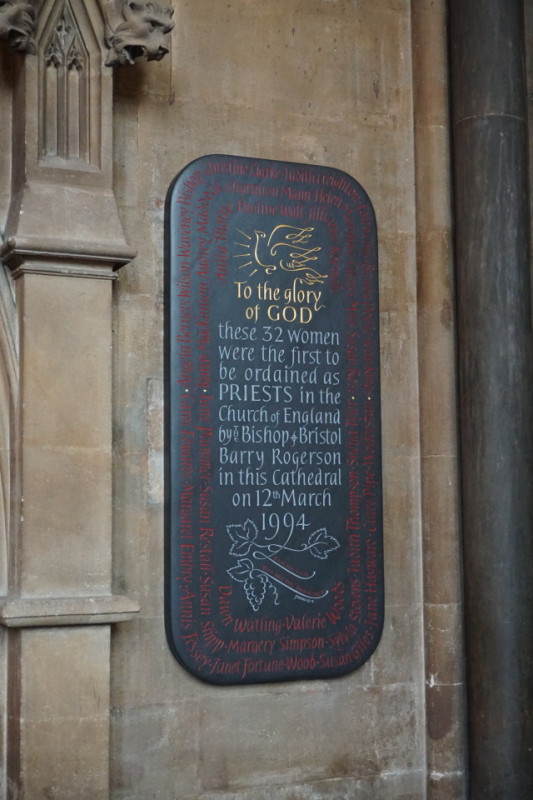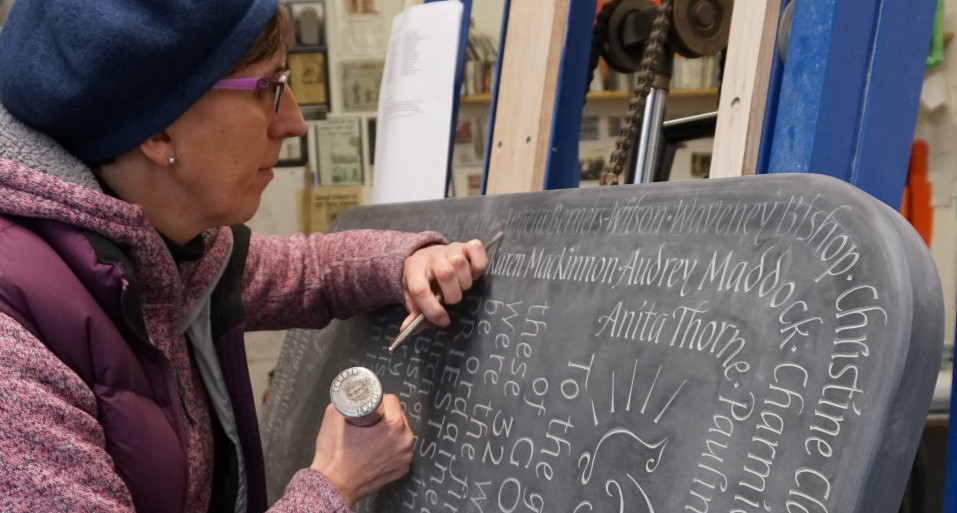
On March 12, 1994, Bristol Cathedral was the first Anglican church to ordain women as priests. On March 12, 2022 a new plaque to mark this historic occasion will be unveiled by The Rt Revd Vivienne Faull, Bishop of Bristol.
The plaque is engraved by Robyn Golden-Hahn who is in her final year as an ordinand in the Sarum Centre for Formation in Ministry.
Robyn Golden-Hahn writes about her experience:
When designing a plaque (or any other monument really), context is important, so site visits were vital. These help me to gather the practical information (size, access, location) but also to get a feel for the environment, to gauge how the proposed works will fit into the context, where it needs to be in sympathy with the surrounding environment, and where, if possible, it might challenge that somewhat.
In this particular instance I felt that the new plaque should represent a very different approach to the extant one, in that, although I used the same material (Welsh Slate), the shape is softer, with rounded corners, rounded edges, and an ever-so-slightly convex shape to suggest femininity. It is much brighter in appearance too, as the text is picked out in different sections in pale grey, red, and gold leaf.
Here I was conscious that this would make the plaque quite noticeable, especially in contrast to those other monuments surrounding it, but given the importance and celebratory nature of the event commemorated it seemed to me highly appropriate. Furthermore, the use of different colours helps to break up the text in order to aid legibility. There is LOT of text on this plaque! I cannot recall how many letters, over 500 characters I think, so the challenge is to create a piece which carries all of that information without it just looking like a ‘shopping list’.
 A plain wall of text can be very hard for the casual viewer to engage with, so I take certain considerations in the design. For example, I always ask myself ‘what is the most important piece of information being conveyed?’ This is usually a name, or, in this case, an event. Therefore, that is given central prominence. The 32 names of all the women surround that main text (this idea was suggested by the cathedral when I was first contacted), and these I have picked out in a darker red. This ensures that they make a notable frame to the main body of text, are legible, but do not take prominence, as, although it’s important that they are named (of course!) I felt that it is the event itself which ought to have the primary visual impact upon the viewer. The names in effect come into clearer view the closer one gets to the plaque.
A plain wall of text can be very hard for the casual viewer to engage with, so I take certain considerations in the design. For example, I always ask myself ‘what is the most important piece of information being conveyed?’ This is usually a name, or, in this case, an event. Therefore, that is given central prominence. The 32 names of all the women surround that main text (this idea was suggested by the cathedral when I was first contacted), and these I have picked out in a darker red. This ensures that they make a notable frame to the main body of text, are legible, but do not take prominence, as, although it’s important that they are named (of course!) I felt that it is the event itself which ought to have the primary visual impact upon the viewer. The names in effect come into clearer view the closer one gets to the plaque.
The lettering is my own creation, based on letter styles I’ve used and adapted over the years, but here I’ve let them become a little looser, replicating a little more of my own hand-writing. Again, this was a conscious decision in order that I might move away from the rigid formality of some of my other works so that this piece would have more freedom of movement, life, and some sort of kinetic energy.
There are two pictograms at the top and bottom of the main inscription. These were my suggestion and I’m delighted that Bristol Cathedral gave me plenty of creative control and freedom here. Theologically I felt it important that the Holy Spirit descending upon the ladies ordained was represented (by the dove) and that the ‘vine and branches’ below emphasised the sense of authority of their calling and ordination as priests by firmly rooting it in Scripture.
This design came together through a few scale sketches (I tend to make very accurate and precise scale drawings) and then in this case I made a full-size ‘cartoon’ of the plaque and pasted that onto cardboard so that I could offer it up in the intended location in order for the dean, Mandy Ford, to give the final nod of approval. From there it went to the Bishop of Bristol for approval and to the Cathedral Fabric Committee.
Inevitably, I’ve put a great deal of emotional investment into this work. This is especially poignant as it marks my last major commission. I cannot think of a more appropriate ‘swan-song’ for my business nor my 30 years as a professional stone-carver; for if it were not for those first 32 women I would not be training for ordained ministry at Sarum!
Many of us owe those trail-blazers a huge debt of gratitude. I am deeply honoured and humbled to have undertaken this work. There is always a lot of work that goes into the creation before I pick up my tools. Much of that is from learned reflective professional experience gathered over the years, but I also think a large part of it is allowing myself to be open, empathic, and even vulnerable to each commission. Subsequently, I often find the creative process to be quite exhausting, draining even, but tremendously fulfilling in equal measure. It’s as if one is being simultaneously emptied and filled.
+++
Robyn Golden-Hann is an award-winning stone-mason whose specialty is bespoke monuments.
Last year, Robyn participated in the Pantheons: Sculpture at St Paul’s Cathedral, c.1796-1916 project. Her contribution is a Calligraphic Response to the Monument Inscriptions: The Monument to Samuel Johnson (1709–1784) by John Bacon the Elder, 1795.

Leave a Reply